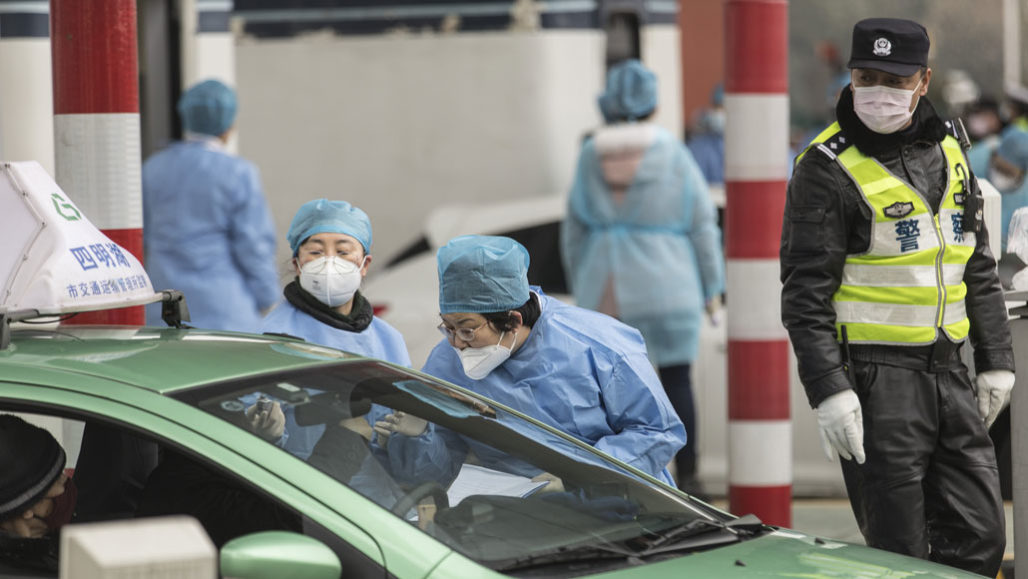The many challenges of corralling a coronavirus outbreak
So many questions about the virus remain that scientists aren’t sure yet how to leash it

Health care workers and police are seen at a highway toll station outside of Shanghai, China. They are checking drivers for symptoms of the new coronavirus. To limit spread of the virus, Chinese officials have quarantined cities, closed businesses and more.
Qilai Shen/Bloomberg/Getty Images
Last month, a new coronavirus emerged in China. Since then, it’s been spreading globally. Chinese officials recently placed millions of people under quarantine. At the same time, airports across the planet have begun screening international travelers for signs of the new pneumonia-like illness. It’s a costly effort and involves a lot of people. But as scientists learn about the new virus, they have doubts about how well these strategies will work at halting a growing epidemic.
The new virus is being called 2019 novel coronavirus, or 2019-nCoV. As of January 28, there have been 4,587 confirmed cases of people infected with the virus (4,528 of them in China). So far, 16 countries report cases. As of today, at least 106 people — all in China — have died. Those numbers come from the European Centre for Disease Prevention and Control.
U.S. officials are monitoring 110 people across 26 states for signs of infection. This virus can cause fever, cough, pneumonia (a type of lung inflammation) and shortness of breath. Those being monitored include people who recently traveled to Wuhan — the city at the center of the outbreak. In addition, health officials are watching the status of others who had direct contact with those travelers. So far, five people in the United States have tested positive for the new virus.
In response to the spiking number of cases, more than 50 million people in China are currently under lockdown. In 2003, a quarantine and isolation helped end the outbreak of another coronavirus. It caused what was known as severe acute respiratory syndrome, or SARS. But researchers are unsure whether this strategy will work as well for 2019-nCoV. Right now, they are scrambling to learn about how this disease spreads. For instance, are people contagious before they show symptoms? And is the virus changing — perhaps becoming easier to transmit — as it spreads from one person to another.
Can people without symptoms spread the disease?
A January 24 paper in the Lancet reported data “consistent with person-to-person transmission” of the virus in hospitals and homes. It concluded that doctors should isolate patients. It also recommended finding out as soon as possible the names and health status of everyone with whom the infected people had recent contact.
Virus spreaders who do not show symptoms make outbreaks hard to control. For instance, despite showing no signs that they are sick, some people with flu or measles will infect others. But it’s uncommon for the types of coronaviruses that cause epidemics to do this, notes Stanley Perlman. He’s a virologist at the University of Iowa in Iowa City.
SARS, for instance, had few such symptom-free victims. That made it relatively easy to find and isolate infected people and to quarantine their contacts.
The two coronaviruses that caused big outbreaks in the past — SARS and Middle East respiratory syndrome, or MERS — both infect the lungs. Being deep in the respiratory tract, they’re harder to transmit without coughing and other symptoms, Perlman says.
2019-nCoV causes symptoms similar to SARS, according to another January 24 paper in the Lancet. These include fever, cough and feeling very tired. But the victims of this virus also lack a runny nose and some of the intestinal symptoms (such as diarrhea) seen with SARS. To spread SARS, “the virus had to get up into the upper airway,” Perlman says. And that wouldn’t happen unless someone was sick enough to start coughing.
Yet on January 26, Chinese officials reported that people with no symptoms may be able to spread 2019-nCoV.
Also unknown: How fast can the new virus spread? Researchers are still figuring out to how many people, on average, a newly infected person might spread the virus. That number is called the R0. The World Health Organization estimates that the R0 for 2019-nCoV’s is between 1.4 and 2.5. However, a study posted January 27 on a research network known as SSRN reports the R0 for the new virus could be as high as 6.5. Still other new papers have estimated that each infected person might spread the virus to between 1.4 and 3.8 others. The study of more cases is needed to home in on the most accurate figure.
Can the outbreak be corralled?
There has never been a quarantine on the scale that China has just put in place. It has halted movement in and out of many cities. It has cancelled big outdoor Chinese New Year celebrations. It has closed big tourist attractions. It has even postponed the start of school.
In all, these measures are effectively quarantining more than 50 million people.
“This is an unprecedented situation,” says Allison McGeer. She’s an infectious disease expert at Mount Sinai Hospital in Toronto, Canada. “Nobody,” she adds, “knows what the right thing to do is.” But she appreciates their dilemma. McGeer herself got SARS in 2003. To slow the spread of any outbreak, she says, programs must limit the virus’ R0. The goal must be to bring this ratio down, on average, to no more than 1. In other words, no infected person should infect more than one other. When that happens, a virus has a good chance of petering out.
China’s major quarantine efforts are trying to bring that ratio down, McGeer says. “But we just don’t know if they’ll work.”

Will wearing masks help? “If you’re infected and you wear a mask, you’ll shed less virus into the air around you,” McGeer says. That might cut the chance that you’ll infect others. For uninfected people, the effects of a mask are less clear. One reason for that: Those masks usually aren’t sealed tight around the nose and mouth. So virus in the air can still come in.
It could be a while before scientists can see whether the lockdown measures have helped. It takes time for a virus to incubate and become detectable. So the recent spike in cases likely are people infected before the January 23 quarantine went into effect.
That quarantine may not be able to prevent a global spread of the infection. “We may have to learn to live with this new virus, just like we live with winter waves of influenza,” McGeer says. While 2019-nCoV has killed dozens and infected thousands, its ultimate impact depends on how severe an illness it causes. And, she points out, “We still don’t really know that.”
For now, most cases have been mild. Only around one in every five infected people suffer severe illness, the World Health Organization reported on January 28. Only a few countries have seen person-to-person spread. Some countries, such as the United States, had time to put good screening procedures in place, adds McGeer. That may help them limit any spread of the new virus.
How much is the virus changing?
All viruses change as they spread between people. That’s because the “machinery” that copies a virus often makes mistakes. Coronaviruses are RNA viruses. And such viruses are well known for having error-prone copying machinery, says Perlman. Such viruses also easily swap parts with other viruses. Bottom line: “They can change a lot.”
But coronaviruses have proof-reading machinery. That tends to make them less error-prone than other RNA viruses, says Mark Denison. He works at Vanderbilt University in Nashville, Tenn. There, he specializes in pediatric infectious diseases and is an expert on coronaviruses. These viruses “are certainly capable of change,” he says. “But in general, once they’ve established a virus that works well, they stabilize that.” He suspects that more changes either hurt the ability of the virus to be copied accurately or have no effect. It’s rare, he says, for these viruses to change and become more infectious or more deadly. And, he adds, there is no sign the new virus is changing much or becoming more dangerous.
Researchers have posted the genetic makeup of more than two dozen samples of the new coronavirus in an online database. Comparing the makeup — or genome — of viruses can help researchers trace where they came from. It also helps them track changes that might make one more or less able to spread and sicken people in the future, Perlman says.
Trevor Bedford works at the Fred Hutchinson Cancer Research Center and the University of Washington. Both are in Seattle, Wash. As an evolutionary biologist, he studies how living things change over the generations or years. So far, the 2019-nCoV isolated from patients in China, Thailand, Japan and the United States are pretty similar. Only five or fewer of the more than 29,000 genetic letters of this virus’s genome differ from patient-to-patient, he says. And eight of the 27 viruses he has studied had no changes. This suggests the virus hasn’t had time to change much.
In fact, he notes, “This lack of genetic diversity fits with an origin in the human population in mid-November.” The data suggest that this virus made a leap from animals to humans just once. Ever since, it has been passing between people. That conclusion, he points out, does not support the idea that many people caught the virus from separate infected animals in a food market. If many animals gave the virus to people, the scientists would expect to see more changes than he has. Bedford is part of a team that posted this conclusion and supporting data on January 25 at nextstrain.org.
So what was the animal source of 2019-nCoV? The virus appears most closely related to a SARS-like coronavirus found in bats. That’s what a team led by Na Zhu of the Chinese Center for Disease Control and Prevention reported January 24. They described this relationship in the New England Journal of Medicine. That doesn’t mean bats passed the virus directly to humans, Bedford says. Another animal could be an intermediate host. “It’s not snakes, though,” he said, referring to a report that snakes could be a reservoir for the virus.
Bats have probably been carrying a similar virus for years. Why it suddenly made the leap to humans last year is unknown, Perlman says. Researchers will continue to look for signs the virus is changing over time, he predicts. SARS developed such gene changes — mutations — that helped it latch onto human cells, he says. Yet in the end, this didn’t help that virus survive. The last known case of SARS was in 2004.
Even if 2019-nCoV mutates in ways that could make it more harmful, only time will tell if this makes the virus more infectious or deadly. From the virus’s point of view, neither is necessarily what it wants. “The goal of a virus is not to kill people,” Perlman explains. “It’s to make more virus.” And it needs a live host to do that.
“We could see a change today and we might think aha! It’s adapting better to humans,” Perlman says. Then, in two weeks it might be gone. Something similar happened with MERS. Researchers detected mutations in the virus that might make it better able to infect people. Still, viruses carrying those changes couldn’t compete with strains without them.







